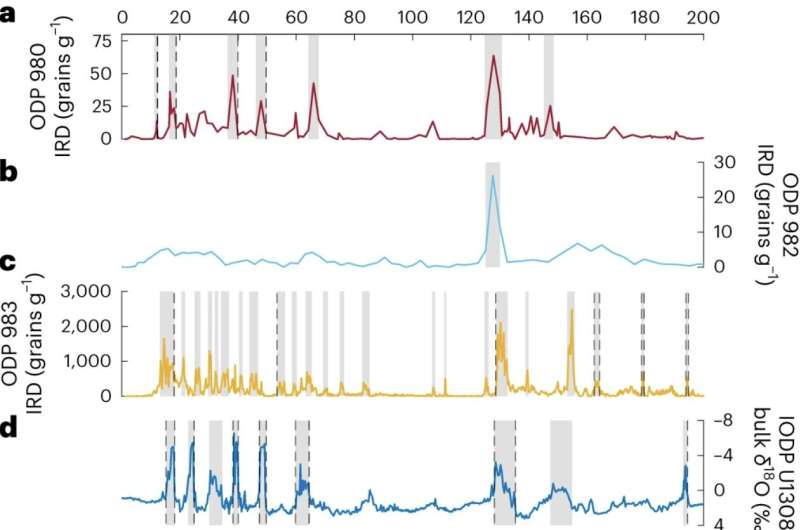August 28, 2023 feature
This article has been reviewed according to Science X's editorial process and policies. Editors have highlighted the following attributes while ensuring the content's credibility:
fact-checked
peer-reviewed publication
trusted source
proofread
New research finds Late Pleistocene glaciations terminated by Earth's axis tilt rather than orbital eccentricity

Glacial cyclicity of the Earth has often been considered on 100,000 year timescales, particularly for the Late Pleistocene (~11,700 to 129,000 years ago) swapping between periods of extensive polar and mountain glacier ice sheets, to warmer interglacial periods when ice sheets and glaciers retreated, with subsequent sea level rise. This is thought to be related to three key drivers affecting the amount of solar radiation reaching Earth from the sun.
Termed Milankovitch cycles, eccentricity considers the shape of Earth's orbit changing from circular to more elliptical over 100,000 year timescales, while obliquity refers to the varying 'tilt' of the planet's axis between 22.1 and 24.5 degrees over 41,000 years (contributing to seasons) and precession, which in simple terms is the direction Earth's axis is pointed and can make the contrast between seasons more extreme in one hemisphere compared to the other.
While the eccentricity cycle has been a major factor thought to drive glacial/interglacial cycles, newer research has suggested that they instead may result from a series of obliquity or precession cycles (especially as the former dominated up to 800,000 years ago). To test this theory, Bethany Hobart, a Doctoral Researcher at the University of California, and colleagues modeled the impacts of glacial termination on 23,000 and 41,000 year cycles.
Three hypotheses were proposed in a Nature Geoscience publication: 1) precession forced by eccentricity, whereby weak precession cycles are associated with near-circular orbits and so summer insolation reaching Earth's surface is low, encouraging ice sheets to accumulate; 2) glaciation terminated every two or three obliquity cycles, therefore roughly every 100,000 years; or 3) both precession and obliquity drove the switch between glaciation and interglaciation.
The research team concluded that it is actually the shortest orbital cycle, precession, that seems to have had the most effect on glacial cyclicity in geological history. For the Late Pleistocene it is the precession forcing in the northern hemisphere during summer that would have helped encourage significant melting of ice sheets and terminated the glacial period.
These findings were based upon oxygen isotopes (the same element with different atomic masses), whereby the warmer conditions cause the evaporation of lighter 16O, leaving the water enriched in heavier 18O which is then incorporated into the shells of organisms living in the ocean, such as single-celled foraminifera.
The microscopic foraminifera are found in sediment cores obtained from the deep ocean, with analyses of Late Pleistocene records identifying distinct rapid decreases in 18O/16O ratios that indicate changes in deep sea temperature resulting from ice volume variation.
Dating the orbital changes relied upon speleothem (mineral deposits in caves; calcite stalactites are an example of one) records from China, producing an age model for the last 640,000 years. Previous research has established that climate changes in the North Atlantic rapidly spread to monsoon regions, with glacial termination corresponding to weaker monsoons, and so the speleothem records can be considered synchronous to ice records.
Through this work, the research team identified nine glacial termination events, with the three marked by an asterisk representing partial termination, while the remainder are fully changing from glacial to interglacial conditions. The precession cycles are noticeably different between the glacial terminations, which Hobart and colleagues suggest may be explained by the competing influence of obliquity, as well as variable ice sheet size at the beginning of each cycle. Therefore, they calculate the duration between the cycles ranging from 90,400 and 115,500 years, with the more distinct changes in precession a clear indicator of the sensitivity of Late Pleistocene ice sheets.
More information: Bethany Hobart et al, Late Pleistocene 100-kyr glacial cycles paced by precession forcing of summer insolation, Nature Geoscience (2023). DOI: 10.1038/s41561-023-01235-x
Journal information: Nature Geoscience
© 2023 Science X Network





















